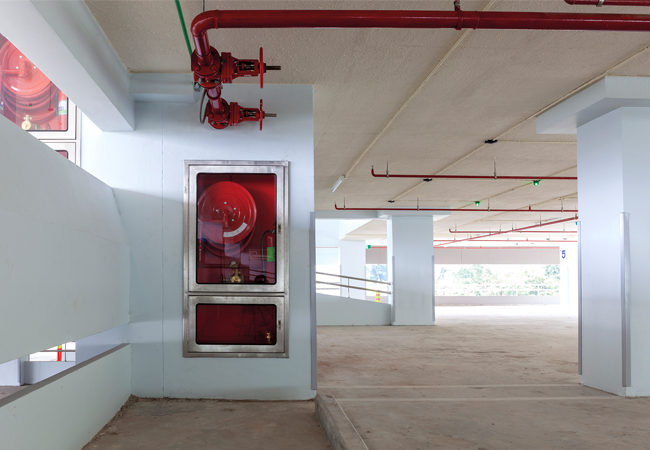
Credit: iStock.com: A stockphoto
A major element of the Building Safety Act is the introduction of the new Building Safety Regulator to oversee all aspects of building safety and the Building Regulations. A key role for the Regulator from 1 October is that they will be the Building Control body for all new higher risk buildings (HRBs) for which applications are made on or after that date.
Parts 1 and 2 of the regulations set out the process for building control of a new HRB and for approval of works to an existing HRB respectively. Regulation 4 sets out in great detail what an application to the new Regulator will require.
This includes all the information that will be required later under the Key Building Information regulations when the HRB is registered. It also requires information about drainage and about the timing of the work. Part 1 implements Gateway 2 for new HRBs and it also specifies the requirements to notify the regulator prior to starting construction on site.
It details the various plans and statements that must be provided with the application. These include plans of the building sufficient to demonstrate that the building work would comply with all applicable requirements of the building regulations’.
In addition, the application will require a competence declaration, a construction control plan, a change control plan, and a mandatory occurrence reporting plan. These will describe how the work is to be undertaken and they tie in with the new duties to plan, monitor and manage the works in the new Part 2A of the Building (Amendment etc) Regulations.
They set out what the applicants plan to do, a plan against which they can be held to account by the regulator. There are always changes on a project, and the requirement here is for them to be properly agreed by all parties (the duty to cooperate applies here), justified, tested for compliance with the regulations, and recorded. If they are significant then they may need to be notified to or fully approved by the Regulator.
In addition, all applications for an HRB will need to be accompanied by a Building Regulations compliance statement, setting out how the proposed design will comply with all aspects of the regulations, as well as a fire and emergency file and a planning statement. In addition, where part of the building will be occupied before completion of the HRB work, a partial completion strategy will be required. Schedule 1 of the regulations defines these documents in more detail.
Finally, any application made on behalf of the client will require a statement signed by the client confirming their agreement to the application being made and to the information it contains.
Part 2 sets out the provisions for applications for approval of work on an existing HRB. Similar documents, plans, and information are required for works to an existing HRB as for a new one.
It is worth noting that Part 2, which covers works to an existing HRB, begins with a provision for undertaking emergency works to an existing HRB. This recognises that something may need urgent and immediate repair to stop leaks or make good damage and that the usual approval process is simply inappropriate. In such a case work can be done, but the Regulator will then need to be informed as soon as practicable.
Except for emergency repairs the Regulator needs to know about and approve the proposals for all building work undertaken on any HRB, new or old.
And as the new rules start to apply from 1 October, with a phased introduction over a six-month period, Accountable Persons will need to have the procedures in place now to notify the Regulator of any such work. There are transitional arrangements that explain when a project will come within the remit of the regulator, with detailed regulations describing a wide range of scenarios for projects in progress. These will need to be carefully read by those responsible for buildings that have begun the building control process under a local authority or private sector building control”.
Bodies such as CIBSE will be working together with the Construction Leadership Council and Its constituent bodies to provide further industry guidance on these regulations and on how clients, principal designers and contractors, and Accountable Persons can meet the new obligations in a safe, reasonable, and proportionate manner. It is another step on the road to rebuilding trust in the construction and operation of our higher rise building stock, and another step on the road to building a safer future.
ABOUT THE AUTHOR
Dr Hywel Davies is a former chair of the Building Regulations Advisory Committee who has worked in the field of regulations and standards for over 35 years. He is chief technical officer of the Chartered Institution of Building Services Engineers and an Honorary Fellow of CIBSE.
- CIBSE will be setting out the breadth of regulatory changes and new requirements of the building regulations at the one day conference: Building Safety: Meeting the Building regulations and delivering the Golden Thread on 28 September, London. For more information and to book visit CIBSE Golden Thread series.
Links to new regulations
The new regulations deliver the recommendations of Dame Judith Hackitt in her report Building A Safer Future and cover the technical detail underpinning the new, more stringent regime for the design and construction of higher-risk buildings, wider changes to the Building Regulations for all buildings and the details of the new in-occupation safety regime for higher-risk buildings.
Amendments announced on August 17 2023:
The Building Regulations etc. (Amendment) (England) Regulations 2023
The Building Regulations (Higher-Risk Building Procedures) (England) 2023
The Building (Approved Inspectors etc. And Review of Decisions) (England) Regulations 2023
The Higher-Risk Buildings (Management of Safety Risks etc) (England) Regulations 2023
The Building Safety Act 2022 (Consequential Amendments etc.) Regulations 2023
A summary of all secondary legislation can be found at:
The Building Safety Act: secondary legislation






